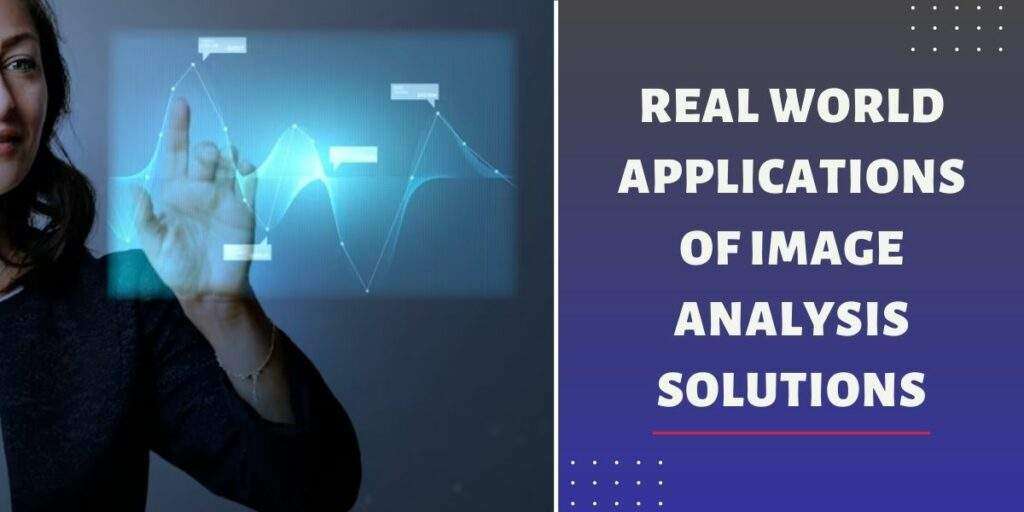
Introduction:
Image analysis is a vital process that extracts valuable information from images, impacting diverse industries. Its importance lies in medical diagnosis, autonomous vehicles, agriculture, surveillance, retail, and environmental monitoring. The rising adoption of image analysis solutions has revolutionized technology, enabling automated tasks, enhanced security, and improved customer experiences. As these solutions continue to evolve, they hold promising potential for further advancements in a wide range of real-world applications.
Overview
Image analysis is a computational technique that interprets and processes visual information from images. Its fundamental principles involve transforming raw pixel data into meaningful insights through algorithms and mathematical operations. Three key techniques are:
1. Object Detection: Identifies and localizes specific objects within an image. Common methods include region-based approaches (e.g., Faster R-CNN) and single-shot detectors (e.g., YOLO).
2. Image Segmentation: Divides an image into distinct regions based on similarities, allowing precise object boundaries. Techniques like U-Net and Mask R-CNN are widely used.
3. Image Classification: Assigns a label or category to an entire image. Convolutional Neural Networks (CNNs) have been highly successful in image classification tasks.
Preprocessing and feature extraction are crucial steps. Preprocessing enhances image quality by reducing noise, resizing, and normalizing. Feature extraction involves identifying meaningful patterns or features in images, facilitating effective analysis and classification. Both the processes significantly contribute to the accuracy and efficiency of image analysis solutions.
Real-World Applications of Image Analysis Solutions
1. Healthcare and Medical Imaging:
In healthcare and medical imaging, image analysis plays a critical role in diagnosing and planning treatments. By analyzing X-rays, MRIs, and other medical images, it aids in identifying diseases and conditions automatically. The techniques enable early detection of diseases like cancer and diabetic retinopathy, leading to timely interventions and improved patient outcomes. Moreover, it assists healthcare professionals in accurately assessing medical images, providing valuable insights for effective diagnosis and personalized treatment strategies.
2. Autonomous Vehicles:
Image analysis in autonomous vehicles ensures safe navigation. It enables vehicles to interpret visual data from cameras and make informed decisions. Object detection and recognition algorithms, such as YOLO and SSD, are employed to identify pedestrians, recognize traffic signs, and detect obstacles on the road. By continuously analyzing the surroundings, autonomous vehicles can respond in real-time to potential hazards, maintaining safety and reliability during their autonomous operations on the roads.
3. Agriculture:
crop monitoring and yield prediction. By analyzing aerial imagery from drones and satellites, farmers can assess crop health more accurately. Image analysis solutions in the USA and worldwide help in identifying pest infestations early, enabling timely interventions to minimize crop damage. The data obtained through analysis aids in precision farming practices, optimizing resource allocation and maximizing crop productivity. This technology-driven approach empowers farmers with valuable insights to make informed decisions and achieve sustainable agriculture practices.
4. Document Processing
Another application is document processing, where it aids in tasks like optical character recognition (OCR), text extraction, and document classification. By converting scanned documents into digital text, the document image processing services help in streamlining data entry, enabling faster and more accurate information retrieval. This technology benefits various industries such as finance, legal, and administrative sectors, improving document management, automating workflows, and enhancing overall productivity. The ability to process large volumes of documents efficiently makes it a valuable tool for businesses seeking to optimize their operations and reduce manual efforts.
5. Surveillance and Security:
Surveillance and security systems can be greatly enhanced by identifying potential threats and criminal activities in real-time. Advanced algorithms enable automatic detection of suspicious behaviors and objects, aiding security personnel in prompt response and prevention. Facial recognition technology plays a significant role in security and law enforcement, allowing for the identification of individuals in crowded places or during investigations. However, ethical considerations and privacy concerns are essential when implementing such technology to balance security needs with individual rights and liberties.
6. Retail and E-commerce:
In retail and e-commerce, customer behavior and preferences are analyzed, leading to tailored product suggestions, increasing customer satisfaction, and boosting sales. Visual search technology allows customers to find products effortlessly by uploading images instead of using keywords. This innovative approach simplifies the shopping process, enhances user engagement, and drives conversions, as customers can easily discover products that align with their visual preferences and style.
7. Environmental Monitoring:
Image analysis plays a vital role in monitoring environmental changes, like deforestation and glacier melting, by analyzing satellite imagery. It enables the detection of land cover changes, helping conservationists and policymakers assess environmental impacts and devise sustainable strategies. Drones equipped with cameras aid wildlife tracking and conservation efforts by capturing high-resolution images of remote areas, allowing researchers to study and protect endangered species.
Conclusion:
In conclusion, image analysis solutions have proven their significance across diverse fields in real-world applications. From healthcare and autonomous vehicles to agriculture and surveillance, these technologies have revolutionized industries, providing invaluable insights and enhancing efficiency. They have facilitated early disease detection, improved road safety, optimized crop management, and bolstered security measures. By enabling personalized experiences in retail and e-commerce, it has elevated customer satisfaction. Moreover, in environmental monitoring, these solutions aid in conservation efforts and tracking wildlife. As technology continues to advance, the future holds exciting possibilities, including even more accurate and real-time analysis, novel applications, and further improvements in various aspects of human life. This transformative potential promises to address complex challenges and usher in a new era of innovation and positive impact on society.


